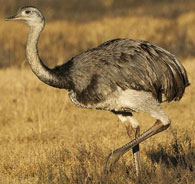Running Birds
What are ostriches?

Ostriches are the largest living birds, growing up to 3 m (9 ft) tall. They are native to the plains of Africa and belong to the 'ratites' or running birds. These large birds can run at speeds of 40 mph. Ostriches live in open, dry country, feeding on succulent plants, fruits, grasses and leaves, as well as occasional insects, lizards, birds and mice.
Ostriches usually live in groups, most commonly one male with three females. The males usually make a nest on the ground and the females lay between 15 and 30 eggs. Males and females incubate the eggs which hatch in 42 days. Ostriches reach full size in six months and can live in the wild for up to 30 years.
What is an emu?

The Emu is the largest bird native to Australia and, after the Ostrich, the second-largest bird that survives today.
It inhabits most of the less-populated areas of the continent, avoiding only dense forest and severe desert. Like all birds in the Ratite group, it is flightless, although unlike some it does have tiny wings hidden under the feathers.
The soft-feathered, brown birds reach 1.5 to 2 m (5 to 6 ft) in height and weigh up to 60 kg, with the male marginally smaller.
Emus are opportunistically nomadic and follow rain, feeding on grains, flowers, fruit, soft shoots, insects, grubs, and whatever else is available. They are able to travel great distances at a fast, economical trot and, if need be, can sprint at 50 km/h.
What is a rhea?

Rheas are large flightless birds native to South America. The name was given in 1752 by Paul Mohring; his reason for choosing this name, from the Rhea of classical mythology, is not known.
Rheas are polygamous, with males courting between two and twelve females. After mating, the male builds a nest, in which each female lays her eggs. The male incubates from ten to sixty eggs; the chicks hatch within 36 hours of each other. The females, meanwhile, may move on and mate with other males. While caring for the young, the males will charge at anyone - including humans and female rheas - who approaches the chicks.
Rheas are omnivorous, preferring broad-leafed plants, but also eating fruit, seeds, roots, insects, and small vertebrates.